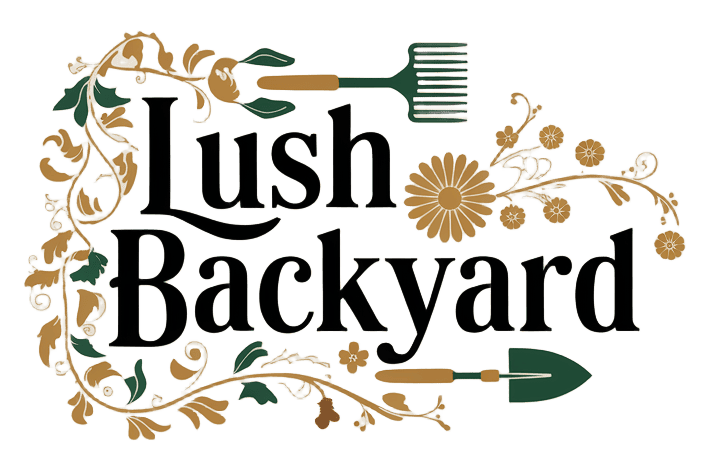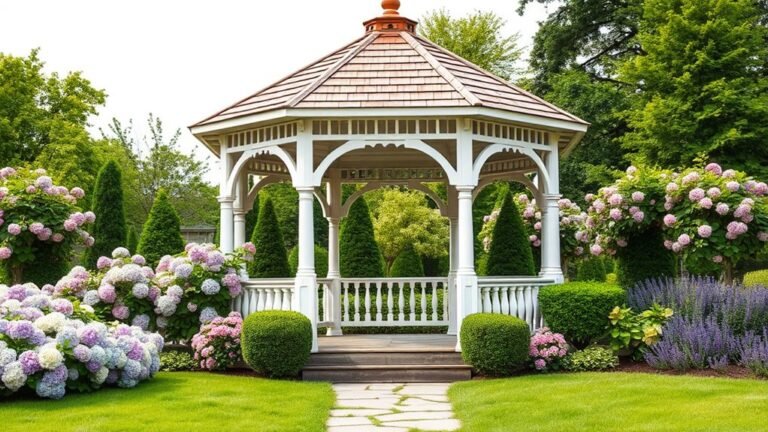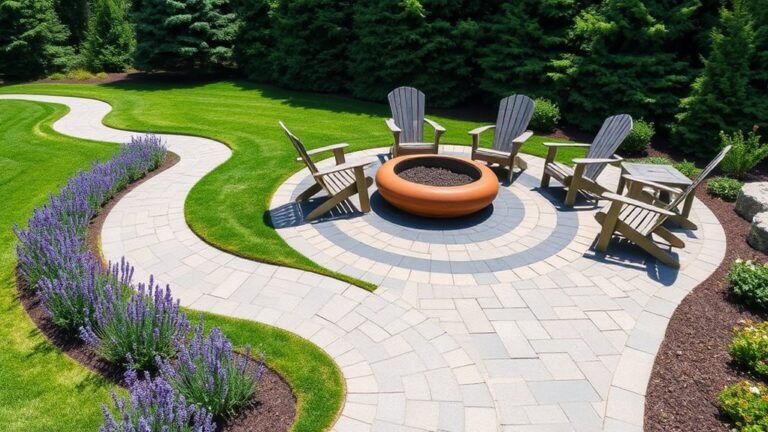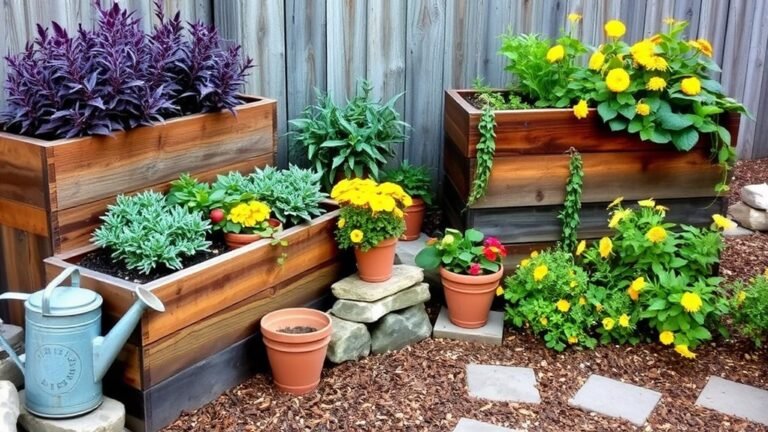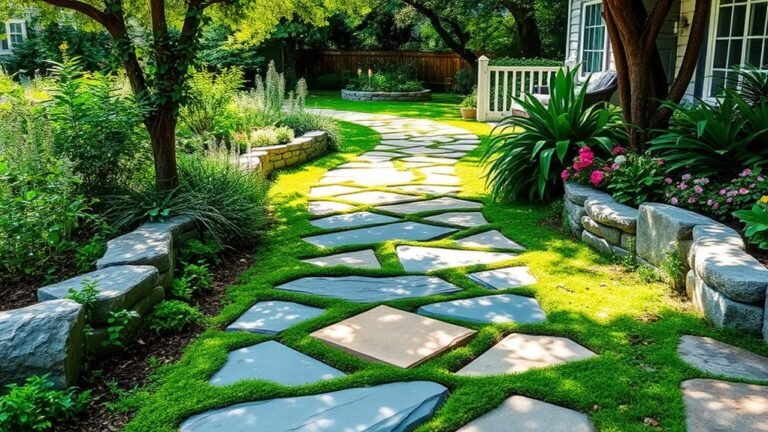23 Backyard Grass Ideas for a Lush Lawn

When designing a lush backyard lawn, consider various grass options like Kentucky Bluegrass for its vibrant hue and Bermuda Grass for its resilience. Don't forget eco-friendly alternatives that can enhance biodiversity and transform your outdoor space.
As you explore these options, effective maintenance tips will help ensure your landscape thrives year-round, while some unconventional solutions may further elevate your outdoor experience. What grass choice will you make to realize your vision?
Kentucky Bluegrass

Kentucky bluegrass is an excellent choice for a lush, vibrant lawn. Its soft, cool turf invites you to enjoy your backyard, showcasing a rich, deep green color and fine texture resembling a plush carpet.
This hardy grass thrives in cool-season areas, making it ideal for chilly spring and fall days, and it offers good drought resistance. Thanks to its underground rhizomes, it spreads to fill in bare spots over time, reducing your maintenance worries.
Kentucky bluegrass thrives in full sun and tolerates partial shade, ensuring even shady spots look attractive. Regular watering and fertilization will keep your lawn looking its best.
You may find yourself appreciating your lawn even more than your garden gnomes! With Kentucky bluegrass, you'll create a beautiful landscape that becomes the envy of your neighborhood.
Bermuda Grass

Bermuda grass is a popular choice for homeowners desiring a durable, dense lawn that withstands heavy foot traffic.
Ideal for hosting barbecues or playing catch, it thrives in sunny areas, making it perfect for outdoor fun.
This warm-season grass grows quickly, allowing for a lush lawn without long waits. Its fine texture feels soft underfoot, enhancing relaxation on sunny days.
Maintenance is key: regular mowing and watering during dry spells are necessary.
With a little care, your Bermuda lawn can become the envy of the neighborhood, transforming your yard into a lush oasis for making memories.
Get ready to enjoy your beautiful green carpet!
Fescue Varieties

Fescue grasses enhance your backyard with their lush appearance and adaptability, making them ideal cool-season choices for a vibrant lawn.
Here are three popular fescue varieties to consider:
- Tall Fescue: Known for its deep roots and drought resistance, it stays green longer during dry spells. It's tough, adaptable, and thrives with regular mowing.
- Fine Fescue: Comprising creeping red fescue, chewings fescue, and hard fescue, this variety is perfect for shaded areas and provides a fine texture. Its softness encourages barefoot enjoyment!
- Kentucky 31: A hardy option for transitional zones, this variety is disease-resistant and performs well in sun or partial shade.
Choose these fescue varieties to elevate your lawn and impress your neighbors!
Zoysia Grass

Zoysia grass is a favored choice for homeowners looking for a resilient lawn that endures heat and foot traffic. It thrives in warmer climates, forming a thick, carpet-like lawn that feels great underfoot and is forgiving during droughts.
One of its advantages is its slow but steady growth, resulting in less mowing during the growing season. However, it can take a while to establish, but once settled, it becomes a reliable lawn companion.
Zoysia offers various varieties suitable for different spaces, whether in sun-soaked areas or partially shaded spots—think of it as lawn matchmaking!
If you desire a lush, golf-course-like backyard, Zoysia grass is the perfect choice, making you the envy of the neighborhood. Get ready to create your fantastic outdoor oasis!
Buffalo Grass

For a low-maintenance, drought-resistant lawn, consider Buffalo grass. This native grass thrives in tough conditions with minimal care, saving you time and money on watering.
Reasons to choose Buffalo grass:
- Drought Resistance: Ideal for areas with limited rainfall, reducing your watering frequency.
- Self-Healing: Quickly recovers from damage, filling in bare spots reliably.
- Low Mowing Needs: Requires mowing just a few times a year, giving you more time for leisure activities.
Creeping Thyme

Creeping Thyme is an ideal fragrant ground cover for your yard. This resilient plant is drought-resistant and thrives underfoot, featuring a soft carpet of vibrant green and purple blooms that exude a delightful herbal aroma.
It flourishes in sunny areas with well-drained soil, making it perfect for filling cracks between stones or creating borders along pathways. Additionally, Creeping Thyme attracts pollinators like bees and butterflies, enhancing your garden's liveliness.
Planting is simple: scatter seeds or place small plugs, and watch them spread with ease.
With minimal maintenance, you can enjoy their beauty throughout the growing season.
Fine Fescue Mix
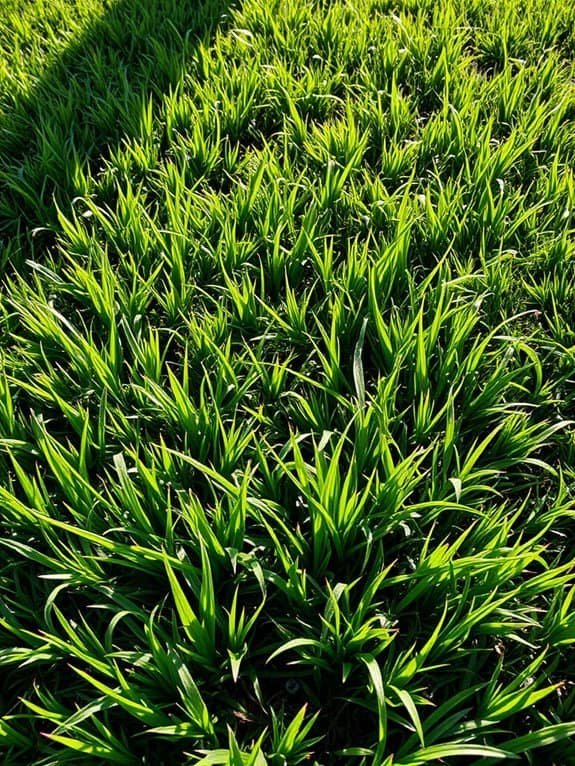
Consider a Fine Fescue Mix for a lush, low-maintenance lawn. This grass blend features various fine fescue species, perfect for homeowners seeking beauty without constant upkeep. Its soft, fine blades invite you to enjoy the outdoors.
Here's why you'll love Fine Fescue Mix:
- Drought-Resistant: It needs less water than other grasses, making it eco-friendly.
- Shade-Tolerant: Fine fescue thrives in shady areas where other grasses struggle, ensuring a uniformly beautiful lawn.
- Low Maintenance: It grows slower than typical grasses, reducing your mowing time and allowing you to enjoy your outdoor space more.
Artificial Turf
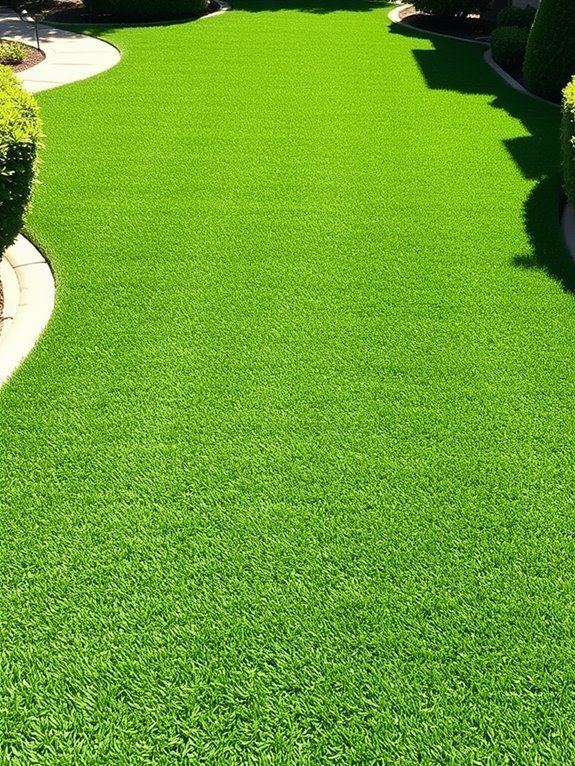
Artificial turf provides homeowners with a stunning lawn that requires minimal upkeep. Imagine stepping onto a flawlessly manicured green surface, free of mowing, watering, or weeding. This extra time allows you to enjoy barbecues, play frisbee, or unwind with a book.
One of the notable benefits of artificial turf is its durability. It maintains its vibrant appearance throughout the year, enduring playtime with kids or pets. Regardless of weather conditions, your lawn remains in excellent condition—just a quick rinse now and then keeps it looking fresh.
Additionally, it's allergy-friendly, eliminating pollen and allowing you to enjoy your outdoor space without sneezing.
Installation is straightforward with some professional assistance, transforming your yard in no time. While the initial cost may seem high, consider the long-term savings on water bills and lawn care services.
Native Grasses
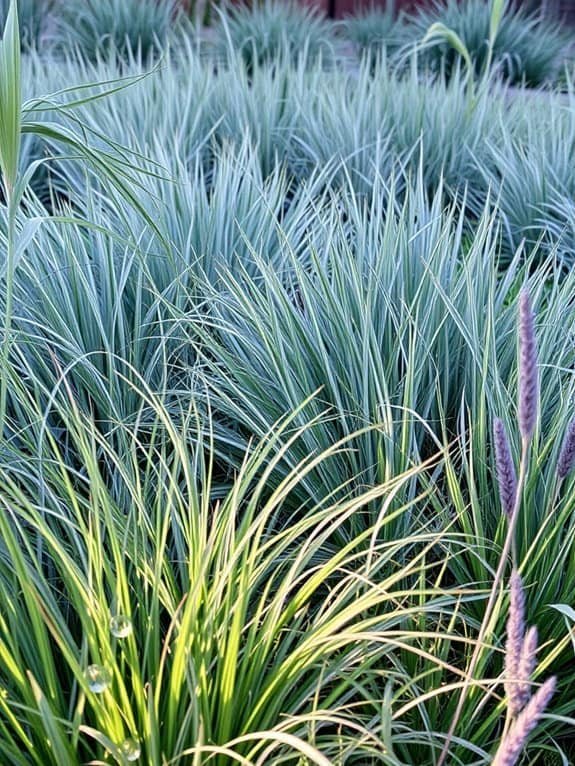
Choosing native grasses for your backyard enhances landscape beauty and supports local ecosystems.
They're resilient, attract wildlife, and are often low-maintenance!
Here are three excellent native grass options:
- Little Bluestem (Schizachyrium scoparium): A beautiful blue-green grass that turns vibrant orange and red in fall.
- Buffalo Grass (Buchloe dactyloides): Ideal for hot, dry areas, this low-water grass offers a plush feel underfoot.
- Prairie Dropseed (Sporobolus heterolepis): With fine, arching foliage, it not only looks great but also emits a delightful fragrance, especially after rain.
Ornamental Grasses

Incorporating ornamental grasses into your backyard adds texture, movement, and year-round visual interest. Available in various sizes, colors, and forms, they're ideal for any garden. Picture the swaying plumes of Miscanthus or the feathery fronds of Pennisetum dancing in the breeze.
These low-maintenance beauties require minimal care once established, freeing you to relax on your porch. Many also provide habitats for beneficial insects and birds, welcoming nature into your space.
Use ornamental grasses as borders, accents, or focal points to enhance your lush lawn. With both clumping and spreading varieties available, choose what suits your space best.
Pair them with colorful perennials for a stunning garden scene that will have your neighbors green with envy!
Drought-Resistant Options

After adding ornamental grasses to your landscape, consider incorporating drought-resistant options to boost your backyard's resilience.
Drought-resistant grasses thrive in dry conditions while providing a lush, low-maintenance look—much like a fabulous, low-effort wardrobe!
Here are three excellent options:
- Buffalo Grass — A native grass that requires minimal water once established, offering a lovely golden hue for your lawn.
- Zoysia Grass — Deep-rooted and resilient, it withstands heat, drought, and foot traffic, feeling like a plush carpet underfoot.
- Fescue — This cool-season grass excels in hot months, retaining moisture and thriving despite the heat, making your yard the neighborhood's envy.
Shade Tolerant Grass

When your backyard is shaded by trees or structures, choosing the right type of grass is crucial for a vibrant lawn. Contrary to popular belief, several shade-tolerant grasses can thrive in less sunlight. Kentucky bluegrass and fescue are excellent options that flourish in dappled light.
For heavy shade, fine fescue is a great choice as it thrives quietly under dense canopies.
These shade-tolerant grasses not only resist low light but often require less water, simplifying your lawn care routine. To ensure healthy growth, provide proper nutrients and clear away obstructive tree branches to allow some sunlight.
With the right grass, your shaded backyard can become a lush oasis and the envy of the neighborhood.
Grass Alternatives

If you want a vibrant outdoor space with reduced maintenance, consider grass alternatives that add charm to your landscape while saving you time.
Here are three excellent options:
- Creeping Thyme: This aromatic ground cover blooms in purple and is drought-resistant, handling foot traffic well—ideal for picnics.
- Moss: Perfect for shady areas, moss offers a low-maintenance, velvety carpet that thrives in conditions where other plants struggle.
- Native Wildflowers: Bringing color and supporting local wildlife, these flowers require minimal watering once established, enhancing your garden's beauty while benefiting the environment.
With these alternatives, you can create a stunning, easy-to-care-for retreat in your backyard!
Low-Maintenance Variety

Exploring grass alternatives can create a low-maintenance backyard with lush greenery!
Consider fine fescue, which thrives in shady areas and requires less water than traditional grass—perfect for enhancing your shaded spots.
Zoysia grass is another excellent option; it grows dense and lush, minimizing weeds while requiring minimal mowing and watering once established. This allows you more time to relax with iced tea on your deck.
For a unique touch, a mix of clover and grass not only beautifies your yard but also attracts pollinators and enriches the soil with nitrogen, acting as a natural fertilizer!
Eco-Friendly Grass

Choosing eco-friendly grass options allows you to create a sustainable backyard that's beautiful and beneficial for the environment.
Imagine relaxing on a lush lawn while contributing to nature—sounds great, right?
Here are three eco-friendly grass types to consider:
- Fine Fescue: Thrives in shade, requires less water, and is low-maintenance.
- Bermudagrass: Ideal for warm climates, this drought-tolerant grass stays vibrant during hot spells.
- Zoysia Grass: Resilient and slow to establish, it develops into a thick lawn and helps reduce soil erosion.
Colorful Grass Blends

Have you ever thought about how a colorful grass blend can enhance your backyard's aesthetic? Mixing grasses like bluegrass, fine fescue, and ryegrass creates a vibrant display that evolves with the seasons, showcasing greens, soft blues, and hints of gold that shimmer in the sunlight.
Colorful grass blends not only look beautiful but also infuse personality into your yard. Experimenting with different textures, shades, and growth patterns allows you to craft a unique landscape that reflects your style. Your lawn will be a conversation starter during barbecues and garden parties, earning you plenty of compliments.
Moreover, these blends usually offer greater resilience. A mix of grass species boosts drought tolerance and pest resistance, enhancing both the appearance and durability of your lawn.
Turf Management Tips

To maintain a lush, healthy lawn, effective turf management is key for growth and pest control. Follow these tips to keep your yard thriving:
- Mow Regularly: Keep mower blades sharp and trim only one-third of the grass height at a time. This promotes deep roots and a denser lawn while reducing weeds.
- Water Wisely: Instead of frequent shallow watering, aim for deep, infrequent sessions—about one inch per week, whether from rain or your hose—to encourage deeper root growth and drought resistance.
- Fertilize Smartly: Use a balanced fertilizer during the growing season for optimal nutrient intake.
Seasonal Grass Care

As seasons change, your lawn's needs shift, requiring tailored care for optimal health.
In spring, awaken your yard by aerating, overseeding, and fertilizing—like a rejuvenating cup of coffee for your grass.
During summer, mow at a higher length to keep roots cool and retain moisture, and water early in the morning to prevent sunburn.
As fall approaches, it's time for cleanup: rake leaves before they turn soggy, and fertilize again to prepare your grass for winter—like tucking it in with a cozy blanket.
Winter can be tough; if snow falls, avoid compacting it by minimizing foot traffic. Your lawn is like you under blankets—cozy and protected.
Seasonal lawn care may seem labor-intensive, but it pays off with a lush, vibrant yard that will make your neighbors envious!
Soil Preparation Techniques

After caring for your lawn year-round, soil preparation is crucial for a thriving backyard.
Think of your soil as the foundation of a home—if it's weak, your grass won't thrive.
Let's dive into three essential soil prep techniques:
- Test the Soil: Use a soil test kit to assess pH levels, ideally between 6.0 and 7.0. Understanding nutrient levels aids in selecting the right amendments.
- Aerate: Utilize a core aerator to create holes in your lawn, allowing air, water, and nutrients to penetrate the soil and promote root growth.
- Add Organic Matter: Incorporate compost or well-rotted manure to enhance soil quality, improve drainage, and supply essential nutrients to your grass.
Implementing these techniques will lead to a lush lawn that your neighbors will envy!
Lawn Edging Ideas

Lawn edging enhances your outdoor space, giving your garden the perfect accessory while preventing grass from invading flowerbeds.
It combines function with flair!
You have several options: use bricks or pavers for a classic, sturdy look, or opt for treated wood edging to add a rustic charm.
For a unique touch, consider natural stone or recycled materials.
Curved edges can bring a playful vibe to your garden, making it an inviting spot for friends to admire while enjoying lemonade on a sunny day.
Who knew lawn maintenance could be so enjoyable?
Pet-Friendly Grass

Choosing the right grass is essential for creating a pet-friendly backyard. You want a lawn that can withstand paw traffic while maintaining its beauty.
Here are three excellent options:
- Perennial Ryegrass: This fast-growing grass establishes quickly and has a fine texture that feels great for both you and your pets.
- Bermudagrass: Durable and drought-resistant, this grass thrives in full sun and withstands heavy foot traffic, making it perfect for pets to run around.
- Tall Fescue: Known for its resilience, this deep-rooted variety tolerates hot weather and boasts a lush appearance.
In short, the right grass choice provides a safe haven for your furry friends while keeping your yard looking fabulous!
Grass Seed Selection

When selecting grass seed for your backyard, consider your local climate and yard conditions.
For warmer regions, opt for sun-loving grasses like Bermuda or Zoysia, which thrive in sunny areas. In contrast, cool-season varieties like Kentucky bluegrass are ideal for northern climates, handling chilly weather well.
If your yard has shady spots, choose shade-tolerant grasses like fescue to enhance those areas.
Additionally, consider how you use your lawn; a hardy grass mix is best for areas with pets or kids, ensuring it can withstand their activities.
Irrigation Solutions

Effective irrigation solutions are crucial for maintaining a healthy lawn during dry spells.
With the right strategies, you can keep your grass lush and green all season.
Here are three irrigation solutions to consider:
- Soaker Hoses: Place these on the soil's surface to slowly release moisture directly into the ground, hydrating your grass without excess water.
- Smart Sprinkler Systems: These devices adjust watering schedules based on rainfall and temperature, acting like a lawn care assistant that knows when to water.
- Rain Barrels: Collect rainwater from your roof for irrigation, saving money and benefiting the environment while utilizing free water.
Frequently Asked Questions
How Do I Know Which Grass Type Suits My Climate?
To figure out which grass type fits your climate, start by checking your zone!
You'll want to look at the temperatures and rainfall. Cool-season grasses thrive in northern areas, while warm-season types love the sun down south.
Don't forget about shade and soil type, either! Testing your soil can reveal its pH and nutrient levels.
With a little research and some trial and error, you'll have the perfect lawn that'll make your neighbors green with envy!
What Are the Costs Associated With Installing New Grass?
When you're diving into installing new grass, think of it like planning a small adventure.
You've got costs to evaluate: seed or sod, which can range from a few hundred to a couple thousand dollars based on your yard size.
Don't forget about soil preparation, and possible irrigation setups. It's a bit of a treasure hunt, but investing now means you'll enjoy a gorgeous, green oasis later.
And let's face it, who doesn't love showing off their lawn?
Can I Mix Different Grass Types in My Lawn?
Absolutely, you can mix different grass types in your lawn!
It's like creating a salad with various ingredients—each type adds its unique flavor. Just make sure they've similar sunlight and water needs to thrive together.
This combo can boost your lawn's resilience and cut down on pests. Plus, who doesn't love a diverse lawn?
Just think of it as a grassy party where everyone's invited, and they're all ready to grow and shine!
How Long Does It Take for Grass Seed to Germinate?
Imagine tiny green soldiers springing up to salute the sun!
Grass seeds usually germinate in about 7 to 14 days, depending on factors like temperature and moisture.
You've gotta keep the soil moist—think of it as giving them a little drink party!
If it gets too chilly, they might take their time coming out, but once they do, you'll feel like a proud parent watching them grow stronger each day.
How exciting, right?
What Tools Are Essential for Lawn Care Maintenance?
When it comes to lawn care maintenance, you'll want to gather some essential tools.
First, grab a quality lawn mower to keep that grass nicely trimmed. A rake is perfect for collecting leaves, and a spade will help with any digging required.
Don't forget a watering can or hose for hydration! A fertilizer spreader can work wonders too.
With these tools in hand, you'll be the proud steward of a thriving lawn. Let's get growing!
Conclusion
Think of your backyard as a blank canvas, ready for a masterpiece. By mixing different grass types and eco-friendly options, you can create a lush, inviting lawn. Consider incorporating colorful perennial flowers and native plants that attract pollinators, offering both beauty and ecological benefits. Additionally, explore backyard landscaping alternatives to grass, such as ground covers or decorative stones, which require less maintenance and water. This approach not only enhances the visual appeal of your outdoor space but also promotes sustainability. Incorporating vibrant flowers and strategically placed shrubs can further enhance your outdoor space, adding depth and color. Explore various backyard landscape design ideas that incorporate pathways and seating areas to create a welcoming environment. By thoughtfully selecting elements that reflect your personal style, you can transform your backyard into a stunning retreat. Experiment with varying textures and colors to enhance your outdoor space, incorporating elements like wildflowers or stone paths for added interest. Explore backyard grass design inspirations that reflect your personal style, ensuring a unique and vibrant atmosphere. Embrace sustainable practices by choosing drought-resistant varieties that are both beautiful and beneficial for the environment. Consider incorporating native plants and decorative stones to enhance the overall aesthetic and biodiversity of your space. Additionally, exploring backyard grass landscaping ideas can help you personalize your outdoor environment, making it a true reflection of your style. Whether you prefer a Zen garden or a vibrant flower bed, the possibilities are endless. Incorporating a variety of plants and flowers will enhance the beauty of your space while attracting local wildlife. Consider exploring backyard garden design ideas that emphasize sustainable practices, such as native plants and vertical gardens, which can add dimension to your landscape. With a little creativity and planning, your backyard can become a vibrant oasis that reflects your personal style.
Whether you're playing fetch with your pup or hosting a summer BBQ, your yard can be the star of the show. With the right care and a touch of creativity, transform your outdoor space into a vibrant paradise you'll love to showcase!
